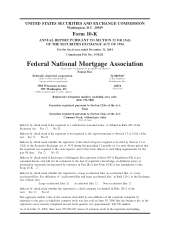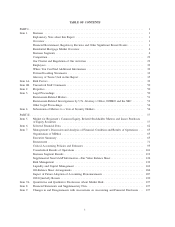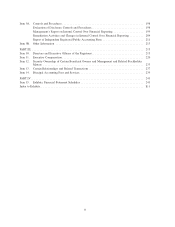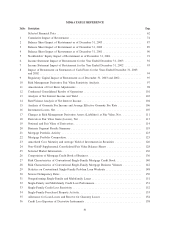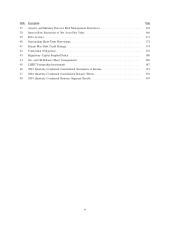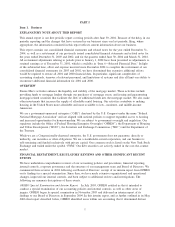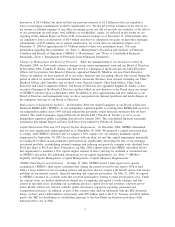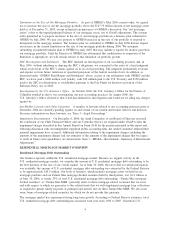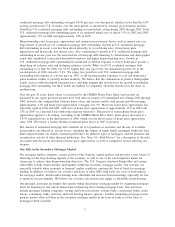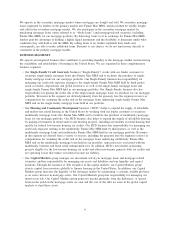Fannie Mae 2004 Annual Report Download - page 7
Download and view the complete annual report
Please find page 7 of the 2004 Fannie Mae annual report below. You can navigate through the pages in the report by either clicking on the pages listed below, or by using the keyword search tool below to find specific information within the annual report.conform to U.S. generally accepted accounting principles (“GAAP”) and specified weaknesses in our internal
controls, compensation practices and corporate governance. We entered into agreements with OFHEO in
September 2004 and March 2005 in which we agreed to take specified actions with respect to our accounting
practices, capital levels and activities, organization and staffing, corporate governance, internal controls,
compensation practices and other matters. See also “OFHEO Final Report and Settlement” below.
Special Review Committee and Paul Weiss Investigation and Report. After receiving OFHEO’s interim report
in September 2004, our Board of Directors established a Special Review Committee of independent directors
to review OFHEO’s findings and oversee an independent investigation of issues raised in the report. The
Special Review Committee engaged former Senator Warren B. Rudman and the law firm of Paul, Weiss,
Rifkind, Wharton & Garrison LLP (“Paul Weiss”) to conduct the investigation and to prepare a detailed report
of its findings and conclusions. Paul Weiss obtained independent professional accounting assistance and, in
February 2006, reported its findings that our accounting practices in many areas were not consistent with
GAAP, and aspects of our accounting were designed to show stable earnings growth and achieve forecasted
earnings. Paul Weiss also concluded that the accounting systems we previously utilized were inadequate.
SEC Review of Our Accounting Practices. Following the receipt of OFHEO’s interim report, we requested that
the SEC’s Office of the Chief Accountant review our accounting practices with respect to two areas identified in
OFHEO’s interim findings – hedge accounting and the amortization of purchase premiums and discounts on
securities and loans, as well as other deferred charges – to determine whether our practices complied with the
applicable GAAP requirements. In December 2004, the SEC’s Office of the Chief Accountant advised us that,
from 2001 to mid-2004, our accounting practices with respect to these two areas did not comply in material
respects with GAAP requirements. Accordingly, the Office of the Chief Accountant advised us to (1) restate our
financial statements filed with the SEC to eliminate the use of hedge accounting and (2) evaluate our accounting
for the amortization of premiums and discounts, and restate our financial statements filed with the SEC if the
amounts required for correction were material. The SEC’s Office of the Chief Accountant also advised us to
reevaluate the GAAP and non-GAAP information that we previously provided to investors, particularly in view
of the decision that hedge accounting was not appropriate.
Accounting-Related Changes and Financial Restatement. After receiving OFHEO’s interim findings and the
SEC’s determination, the Audit Committee of our Board of Directors concluded in December 2004 that our
previously filed interim and audited consolidated financial statements should not be relied upon since they were
prepared applying accounting practices that did not comply with GAAP and, consequently, we would restate our
consolidated financial statements. As part of the restatement, we have undertaken a comprehensive review of, and
made numerous corrections to, our accounting policies and procedures as well as the information systems used to
produce our accounting records and financial reports. The consolidated financial statements for the years ended
December 31, 2003 and 2002 included in this Annual Report on Form 10-K include restatement adjustments that
we have categorized into the following seven areas: our accounting for debt and derivatives; our accounting for
commitments; our accounting for investments in securities; our accounting for MBS trust consolidation and sale
accounting; our accounting for financial guaranties and master servicing; our accounting for amortization of cost
basis adjustments; and other adjustments.
The overall impact of our restatement was a total reduction in retained earnings of $6.3 billion through
June 30, 2004. This amount includes:
• a $7.0 billion net decrease in earnings for periods prior to January 1, 2002 (as reflected in beginning
retained earnings as of January 1, 2002);
• a $705 million net decrease in earnings for the year ended December 31, 2002;
• a $176 million net increase in earnings for the year ended December 31, 2003; and
• a $1.2 billion net increase in earnings for the six months ended June 30, 2004.
We previously estimated that errors in accounting for derivative instruments, including mortgage commitments,
would result in a total of $10.8 billion in after-tax cumulative losses through December 31, 2004. In a
subsequent 12b-25 filing in August 2006, we confirmed our estimate of after-tax cumulative losses on
2

